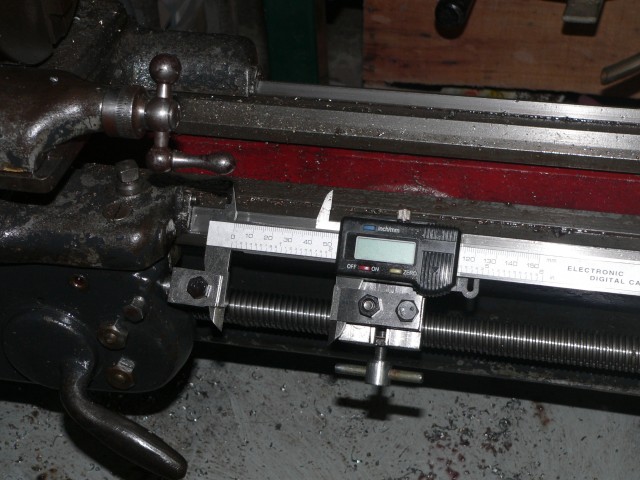
Hercus Model VBC Lathe

 |
Hercus Model VBC Lathe |
 |
Not being a machinist I don't know how people measure carriage travel when turning for a precise length. Some lathes have a dial on the carriage handwheel and this seems convenient although perhaps not as accurate as might be required. For the Hercus I wanted a digital scale.
The design requirements for this upgrade included :
Luckily Mr Hercus drilled a hole in the right-hand side of the apron and since this is unused I could use it to mount the apron bracket. The other bracket clamps to the bed. This is more complicated than a normal carriage stop because the position of the caliper precludes having the tightening screw in the normal position. A screw underneath would work but be inconvenient for access as it would be behind the caliper and above the leadscrew. The bracket here has a sliding jaw pushed by the bolt at the bottom of the bracket. The picture on the right shows the brackets without the caliper for clarity.
The two brackets have clamps that hold the jaws of the caliper. The apron bracket was easy to make. The bed bracket was much more involved. The viewing angle of the caliper is set by the bed bracket that rests on the front sloping edge of the bed. The apron bracket is positioned to match this angle.
Picture of the disassembled brackets on the left. The right-hand picture shows the jaw that clamps the bracket to the bed.
The holder (with a digital caliper) certainly makes turning for a precise distance much easier and quicker. The hassle with a digital caliper is that the battery goes flat. However, such a caliper is resettable meaning I can set it to zero at the tailstock end of the work each time I change tools or anything else that loses the previous alignment. Most calipers power-off automatically after a while if no movement is detected. This is good except for those that lose their position when they power-off or silly ones where you have to press the reset button to turn them back on (and set the position to zero). So, not all calipers are suitable here. A good one is great.
A carriage stop would also be a useful addition as it is fiddly advancing the carriage for the last few thou. Advancing the carriage by manually turning the leadscrew works well and would be better if I had a little handle on the leadscrew.

Rather than disconnect and remove the scale when not needed I've found it easier just to loosen the bed clamp bolt so the entire scale slides with the carriage. To make this easier the replacement bolt has a T-handle so I can lock or release it by hand. When not in use I also tighten the thumb screw on the top of the caliper as any movement here causes the display to switch on and waste the battery. This auto-on shows that the caliper sensor is always active and chewing a bit of battery power. This is good because any movement is detected whether the caliper is on or off and it remains accurate.
The battery here is a cheap one (LR not SR) and it's lasted more than two months so far. Things are looking good.
Report pages :
Last modified 2010-09-24